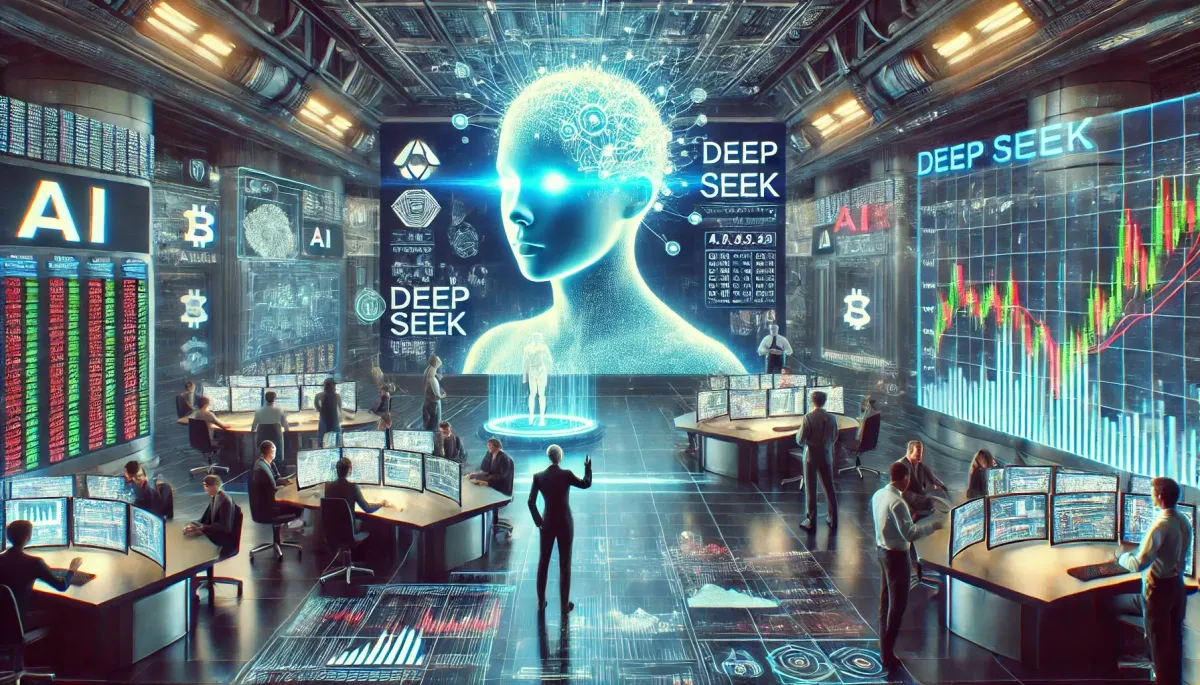Our Blog

The AI Wars Heat Up: Deep Seek's Challenge to OpenAI's Dominance
The AI Wars Heat Up: Deep Seek's Challenge to OpenAI's Dominance
In the ever-evolving landscape of artificial intelligence, a new player has emerged that's sending shockwaves through the industry. Deep Seek has burst onto the scene with a bold promise: AI technology that's up to eight times cheaper than the current market leader, OpenAI. But what does this mean for the future of AI, the stock market, and the tech industry as a whole? Let's dive deep into this developing story.
The New Kid on the Block: Deep Seek's Disruptive Entry
Remember when everyone thought OpenAI had an unshakeable grip on the AI market? Well, times are changing, and they're changing fast. Deep Seek has emerged from relative obscurity to become the talk of the tech world, thanks to their innovative PTX architecture that stands in stark contrast to OpenAI's CUDA-based systems.
What makes this particularly interesting is that Deep Seek isn't just another AI startup making big promises. They're delivering results that are turning heads in Silicon Valley and beyond. The company's approach to AI processing is fundamentally different, leading to significant cost savings that could reshape the entire industry.
However, this success hasn't come without controversy. Whispers in the tech community suggest that Deep Seek might have gotten their hands on some of OpenAI's training methods through leaks. While these remain unconfirmed speculations, they've added an extra layer of intrigue to an already fascinating story.
Microsoft's Strategic Pivot: A Game-Changing Move
Here's where things get really interesting. Microsoft, despite having what many considered a rock-solid partnership with OpenAI (including an almost 50/50 profit share), has made a move that nobody saw coming: they've started integrating Deep Seek's AI into Windows Copilot and their cloud services.
This isn't just a minor business decision – it's a seismic shift in the AI landscape. Microsoft's move signals that even the biggest players in tech are willing to prioritize cost-effectiveness over existing partnerships. It's a wake-up call for OpenAI and a clear indication that no company's position in the AI race is secure.
The Great AI Migration: Companies Exploring Alternatives
The ripple effects of Deep Seek's emergence are being felt throughout the industry. Companies that have been relying on OpenAI's API are now actively exploring Deep Seek as an alternative, drawn by the promise of significant cost savings. This shift isn't happening in a vacuum – it's part of a larger trend where businesses are becoming more conscious about their AI expenditure.
OpenAI isn't likely to take this lying down. With access to Deep Seek's open-source code, they're expected to respond quickly. This could lead to a fascinating period of rapid innovation as both companies try to outmaneuver each other. However, it's worth noting that despite the dramatic headlines, we're not seeing an immediate monopolistic disruption of the market.
Technical Revolution: The Promise of Local AI Processing
One of the most exciting aspects of Deep Seek's technology is its potential to revolutionize how we process AI tasks. Their R1 model, which Microsoft has already implemented in Azure and cloud services, could pave the way for local AI processing on personal computers. This would be a game-changer, potentially reducing our dependence on cloud computing for AI tasks.
Some analysts are calling this a "Black Swan event" for the AI industry, but it's important to maintain perspective. While the technology is promising, the market's reaction has been measured rather than panic-driven. This suggests that industry experts see this as an evolution rather than a revolution.
Market Stability in the Face of Change
Despite the dramatic headlines and predictions of doom, the stock market has remained remarkably stable throughout these developments. This stability tells us something important: while Deep Seek's emergence is significant, it's not causing the kind of market disruption that some feared.
For investors, this presents an interesting situation. While it's important to stay informed about these developments, the market's stability suggests that long-term investment strategies shouldn't be abandoned in favor of reactive decisions based on sensationalist narratives.
The Global Chess Game: AI's Uncertain Future
The plot thickens when we consider the global implications of Deep Seek's rise. Some industry observers have suggested that China might be using Deep Seek as a strategic move to disrupt Western AI markets. While this remains speculative, it adds another layer of complexity to an already multifaceted situation.
The future of AI leadership is far from certain. While OpenAI currently holds a dominant position, the rapid pace of innovation means that leadership could shift to Deep Seek, Google, or even currently unknown players. This uncertainty is both exciting and challenging for investors and industry participants alike.
What This Means for Investors and Traders
For those involved in the market, whether as investors or traders, the key takeaway is the importance of maintaining a balanced perspective. While the AI landscape is undoubtedly changing, the market's stability suggests that dramatic actions aren't necessary.
Technical analysis, rather than fear-based decision-making, should continue to guide trading decisions. The market has shown remarkable resilience in the face of these changes, and there's no indication that this will change in the immediate future.
Looking Ahead: The Future of AI Competition
As we look to the future, several key questions emerge:
1. How will OpenAI respond to this new challenge to their dominance?
2. Will Microsoft's bet on Deep Seek pay off in terms of cost savings and technological advancement?
3. Could this competition lead to even more innovative AI solutions that benefit end-users?
What's clear is that the AI industry is entering a new phase of competition and innovation. This competition is likely to drive down costs while pushing the boundaries of what's possible with AI technology.
Embracing Change While Maintaining Perspective
The emergence of Deep Seek as a serious competitor to OpenAI marks an important milestone in the evolution of AI technology. While the implications are significant, the market's measured response suggests that this is a development to be monitored rather than feared.
For investors, companies, and technology enthusiasts, the key is to stay informed while avoiding knee-jerk reactions to market speculation. The AI landscape will continue to evolve, and those who maintain a balanced, long-term perspective will be best positioned to benefit from these changes.
Remember, in the world of technology and investment, dramatic headlines often mask more nuanced realities. As we continue to monitor these developments, focusing on concrete developments rather than speculation will be crucial for making informed decisions.
The AI wars are heating up, but rather than causing market chaos, they're driving innovation and competition in ways that could benefit everyone involved. Stay tuned for more developments in this fascinating space, and remember that in the world of technology, today's disruptor could be tomorrow's disrupted.
What are your thoughts on these developments in the AI industry? How do you see the competition between Deep Seek and OpenAI playing out? Share your perspectives and join the conversation about the future of AI technology.
Blog & Articles

The AI Wars Heat Up: Deep Seek's Challenge to OpenAI's Dominance
The AI Wars Heat Up: Deep Seek's Challenge to OpenAI's Dominance
In the ever-evolving landscape of artificial intelligence, a new player has emerged that's sending shockwaves through the industry. Deep Seek has burst onto the scene with a bold promise: AI technology that's up to eight times cheaper than the current market leader, OpenAI. But what does this mean for the future of AI, the stock market, and the tech industry as a whole? Let's dive deep into this developing story.
The New Kid on the Block: Deep Seek's Disruptive Entry
Remember when everyone thought OpenAI had an unshakeable grip on the AI market? Well, times are changing, and they're changing fast. Deep Seek has emerged from relative obscurity to become the talk of the tech world, thanks to their innovative PTX architecture that stands in stark contrast to OpenAI's CUDA-based systems.
What makes this particularly interesting is that Deep Seek isn't just another AI startup making big promises. They're delivering results that are turning heads in Silicon Valley and beyond. The company's approach to AI processing is fundamentally different, leading to significant cost savings that could reshape the entire industry.
However, this success hasn't come without controversy. Whispers in the tech community suggest that Deep Seek might have gotten their hands on some of OpenAI's training methods through leaks. While these remain unconfirmed speculations, they've added an extra layer of intrigue to an already fascinating story.
Microsoft's Strategic Pivot: A Game-Changing Move
Here's where things get really interesting. Microsoft, despite having what many considered a rock-solid partnership with OpenAI (including an almost 50/50 profit share), has made a move that nobody saw coming: they've started integrating Deep Seek's AI into Windows Copilot and their cloud services.
This isn't just a minor business decision – it's a seismic shift in the AI landscape. Microsoft's move signals that even the biggest players in tech are willing to prioritize cost-effectiveness over existing partnerships. It's a wake-up call for OpenAI and a clear indication that no company's position in the AI race is secure.
The Great AI Migration: Companies Exploring Alternatives
The ripple effects of Deep Seek's emergence are being felt throughout the industry. Companies that have been relying on OpenAI's API are now actively exploring Deep Seek as an alternative, drawn by the promise of significant cost savings. This shift isn't happening in a vacuum – it's part of a larger trend where businesses are becoming more conscious about their AI expenditure.
OpenAI isn't likely to take this lying down. With access to Deep Seek's open-source code, they're expected to respond quickly. This could lead to a fascinating period of rapid innovation as both companies try to outmaneuver each other. However, it's worth noting that despite the dramatic headlines, we're not seeing an immediate monopolistic disruption of the market.
Technical Revolution: The Promise of Local AI Processing
One of the most exciting aspects of Deep Seek's technology is its potential to revolutionize how we process AI tasks. Their R1 model, which Microsoft has already implemented in Azure and cloud services, could pave the way for local AI processing on personal computers. This would be a game-changer, potentially reducing our dependence on cloud computing for AI tasks.
Some analysts are calling this a "Black Swan event" for the AI industry, but it's important to maintain perspective. While the technology is promising, the market's reaction has been measured rather than panic-driven. This suggests that industry experts see this as an evolution rather than a revolution.
Market Stability in the Face of Change
Despite the dramatic headlines and predictions of doom, the stock market has remained remarkably stable throughout these developments. This stability tells us something important: while Deep Seek's emergence is significant, it's not causing the kind of market disruption that some feared.
For investors, this presents an interesting situation. While it's important to stay informed about these developments, the market's stability suggests that long-term investment strategies shouldn't be abandoned in favor of reactive decisions based on sensationalist narratives.
The Global Chess Game: AI's Uncertain Future
The plot thickens when we consider the global implications of Deep Seek's rise. Some industry observers have suggested that China might be using Deep Seek as a strategic move to disrupt Western AI markets. While this remains speculative, it adds another layer of complexity to an already multifaceted situation.
The future of AI leadership is far from certain. While OpenAI currently holds a dominant position, the rapid pace of innovation means that leadership could shift to Deep Seek, Google, or even currently unknown players. This uncertainty is both exciting and challenging for investors and industry participants alike.
What This Means for Investors and Traders
For those involved in the market, whether as investors or traders, the key takeaway is the importance of maintaining a balanced perspective. While the AI landscape is undoubtedly changing, the market's stability suggests that dramatic actions aren't necessary.
Technical analysis, rather than fear-based decision-making, should continue to guide trading decisions. The market has shown remarkable resilience in the face of these changes, and there's no indication that this will change in the immediate future.
Looking Ahead: The Future of AI Competition
As we look to the future, several key questions emerge:
1. How will OpenAI respond to this new challenge to their dominance?
2. Will Microsoft's bet on Deep Seek pay off in terms of cost savings and technological advancement?
3. Could this competition lead to even more innovative AI solutions that benefit end-users?
What's clear is that the AI industry is entering a new phase of competition and innovation. This competition is likely to drive down costs while pushing the boundaries of what's possible with AI technology.
Embracing Change While Maintaining Perspective
The emergence of Deep Seek as a serious competitor to OpenAI marks an important milestone in the evolution of AI technology. While the implications are significant, the market's measured response suggests that this is a development to be monitored rather than feared.
For investors, companies, and technology enthusiasts, the key is to stay informed while avoiding knee-jerk reactions to market speculation. The AI landscape will continue to evolve, and those who maintain a balanced, long-term perspective will be best positioned to benefit from these changes.
Remember, in the world of technology and investment, dramatic headlines often mask more nuanced realities. As we continue to monitor these developments, focusing on concrete developments rather than speculation will be crucial for making informed decisions.
The AI wars are heating up, but rather than causing market chaos, they're driving innovation and competition in ways that could benefit everyone involved. Stay tuned for more developments in this fascinating space, and remember that in the world of technology, today's disruptor could be tomorrow's disrupted.
What are your thoughts on these developments in the AI industry? How do you see the competition between Deep Seek and OpenAI playing out? Share your perspectives and join the conversation about the future of AI technology.
Post Address and Mail
Email: [email protected]
Address
Mail: 7558 W Thunderbird Rd
STE 1-623 Peoria, AZ 85381
Get In Touch
Assistance Hours
Mon – Fri 9:00am – 5:00pm
Saturday – CLOSED
Sunday – CLOSED
Phone Number:
602-854-9823
Mail: 7558 W Thunderbird Rd
STE 1-623 Peoria, AZ 85381
Call
602-854-9823
Email:[email protected]
Site: www.bizMelio.com


